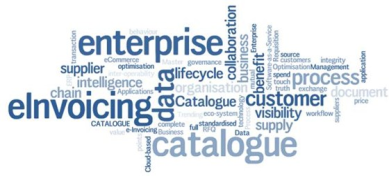eInvoicing is the source of truth, isn’t it?

The disciplines focussed on Business Process Optimisation cover a broad spectrum, but a current subject that is Trending high in the world of Enterprise Applications is eInvoicing. I read with some interest the other day how the concept of eInvoicing was described and questioned the benefit.
The explanation read,
“eInvoicing, sometimes referred to as electronic invoicing or e-Invoicing, is the exchange of the invoice document between a supplier and a buyer in an electronic format. Traditionally, invoicing, like any heavily paper-based process, has taken up a lot of time and is prone to human error. The result has been increased cost and reduced revenue for companies.”So there you go, the benefit is evident but has a full optimisation been realised, if you extend the document transaction process and have the full lifecycle incorporated into existing workflow of document exchange between your organisation and your customer or supplier then you can claim you have.
However, the reduction of touch points to any process is how you achieve optimisation, so taking the process back to RFQ and Requisition provides layers of benefit that could remain unrealised. So eInvoicing is in essence not your source of the truth as integral to each transaction is the product and service repository that initiated the transaction, the
CATALOGUE, that manages the data and provides value across the enterprise. With the deployment of a catalogue any enterprise can have standardised data running through their enterprise, allowing them to have consistent business intelligence across the complete lifecycle of the supply chain process that then feeds into effective and instant benchmarking.
It’s not just a one sided benefit. If the enterprise is acting in its capacity as a supplier as well as a customer, this catalogue data enables both sides of the organisation to contribute effective intelligence and visibility to customer behaviour or spend, but more importantly it extends the visibility either way along the supply chain and enables greater collaboration and mutual benefit to the eco-system of any enterprise, not just the one organisation. It’s well documented that mutual benefit from collaboration delivers greater value than purely negotiating on price. The catalogue gives control to the business and removes constraints of data governance environments like Master Data Management and ERP application, but works with them to ensure data integrity is maintained and contributes further value to the business.
With the introduction of a Catalogue and with Cloud-based technology providers, or Software as a Service (SaaS) providers, the enterprise can still retain control without having the cost of maintaining on-premise systems and the challenge of integrating applications. So this enables businesses to increase their inter-operability between themselves and their peer organisations in their eco-system and so provides mutual benefit to all.
The take-away is simple, don’t break a process down into modules and then solely address the easy bits, grasp the entire process. Certainly implement in modules but address the end to end process, working with technology providers that offer end-to-end technology. But most important of all is to realise the full value of the central data repository, the catalogue, for the products and services involved in the process. Many applications negate the use of a Catalogue, but if you pursue the discussion further you quickly establish the architecture of their application is the restrictive element and not the value the catalogue brings. Implement a catalogue as a key tool to your eBusiness initiatives, be it in your demand or supply chain applications, and the full value is then realised within the organisation as well as by your customers and your suppliers.